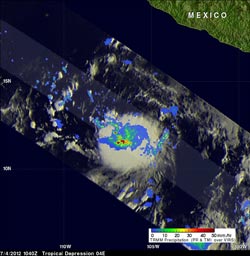NASA Sees Tropical Fireworks in E. Pacific in Newborn Tropical Storm Daniel

When TRMM passed over TD 4E on July 4, 2012, it saw strong convective storms were dropping heavy rainfall (red) near the center of the tropical depression's center of circulation. That rain was falling at a rate of more than 2 inches/50 mm per hour. TRMM's Precipitation Radar (PR) instrument found that a few of these towering storms reached heights of about 15 km (~9.3 miles).<br>Credit: SSAI/NASA, Hal Pierce <br>
The TRMM satellite got a very good look at recently formed Tropical Depression 4E (TD 4E) at 1040 UTC (6:40 a.m. EDT) on July 4, 2012. The hot towering cumulonimbus clouds called “hot towers” shooting up like a roman candle around the center of circulation provide the fireworks for the depression.
A “hot tower” is a rain cloud that reaches at least to the top of the troposphere, the lowest layer of the atmosphere. It extends approximately nine miles (14.5 km) high in the tropics. These towers are called “hot” because they rise to such altitude due to the large amount of latent heat. Water vapor releases this latent heat as it condenses into liquid.
Research by Owen Kelley and John Stout of George Mason University and NASA's Goddard Space Flight Center, Greenbelt, Md., shows that a tropical cyclone with a hot tower in its eyewall was twice as likely to intensify within the next six hours than a cyclone that lacked a tower and Tropical Depression 4E became Daniel by 11 a.m. EDT on July 5.
When TRMM passed over TD 4E, rainfall data from TRMM's Microwave Imager (TMI) and Precipitation Radar (PR) instruments revealed that strong convective storms were dropping heavy rainfall near the center of the tropical depression's center of circulation. TRMM's Precipitation Radar (PR) instrument found that a few of these towering storms reached heights of about 15 km (~9.3 miles). TRMM PR also found that rainfall within TD 4E was returning reflectivity values of over 51.5 dBZ. Those data provided additional proof that heavy rainfall was occurring within TD 4E.
At 5 p.m. EDT on July 4, the depression has maximum winds near 35 mph/55 kmh, and is about 445 miles (715 km) south-southwest of Manzanillo, Mexico. That's near 13.5 North and 107.8 West. It was moving to the west-northwest at 13 mph/20 kmh and headed away from land and out to sea.
At 11 a.m. EDT (8 a.m. PDT) on July 5, 2012, Tropical Depression 4E became Tropical Storm Danie with maximum sustained winds now near 45 mph (75 kmh). It was located near latitude 14.2 north and longitude 110.5 west. That's about 600 miles (970 km) south of the southern tip of Baja California. Daniel is moving toward the west-northwest near 12 mph (19 kmh). That general motion is forecast to continue, followed by a turn to the west, according to the National Hurricane Center.
Text Credit: Rob Gutro / Hal Pierce
NASA Goddard Space Flight Center / SSAI, Greenbelt, Md.
Media Contact
All latest news from the category: Earth Sciences
Earth Sciences (also referred to as Geosciences), which deals with basic issues surrounding our planet, plays a vital role in the area of energy and raw materials supply.
Earth Sciences comprises subjects such as geology, geography, geological informatics, paleontology, mineralogy, petrography, crystallography, geophysics, geodesy, glaciology, cartography, photogrammetry, meteorology and seismology, early-warning systems, earthquake research and polar research.
Newest articles

Bringing bio-inspired robots to life
Nebraska researcher Eric Markvicka gets NSF CAREER Award to pursue manufacture of novel materials for soft robotics and stretchable electronics. Engineers are increasingly eager to develop robots that mimic the…

Bella moths use poison to attract mates
Scientists are closer to finding out how. Pyrrolizidine alkaloids are as bitter and toxic as they are hard to pronounce. They’re produced by several different types of plants and are…

AI tool creates ‘synthetic’ images of cells
…for enhanced microscopy analysis. Observing individual cells through microscopes can reveal a range of important cell biological phenomena that frequently play a role in human diseases, but the process of…





















